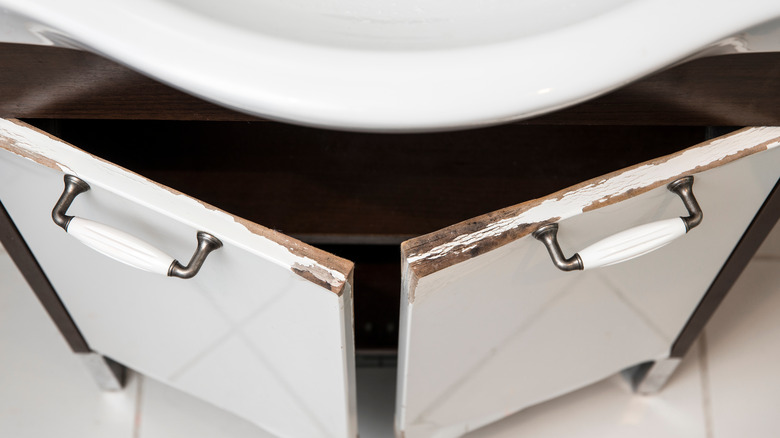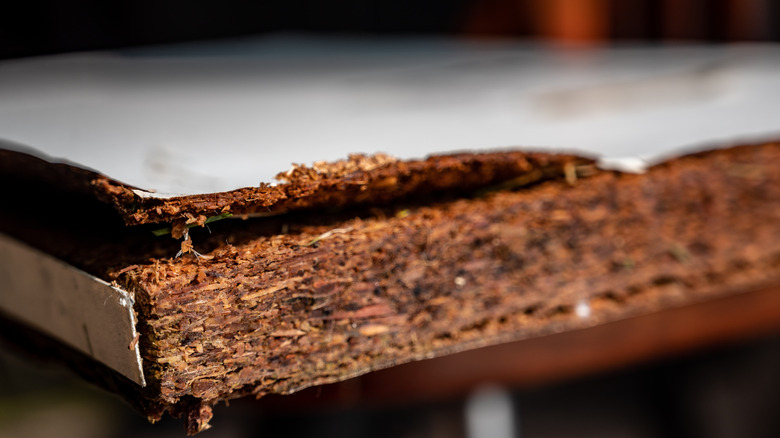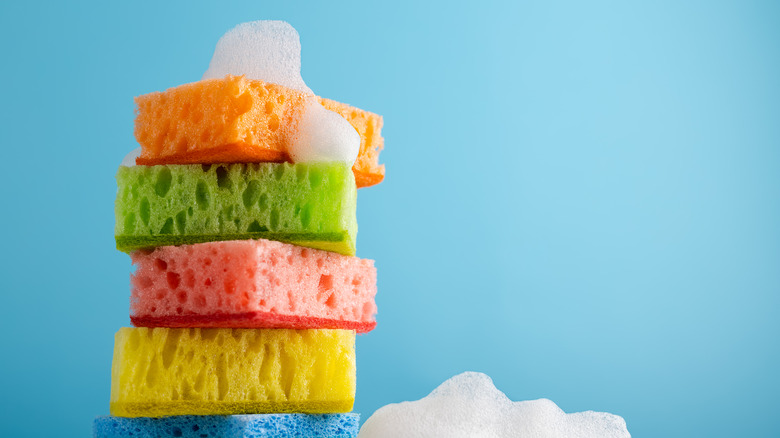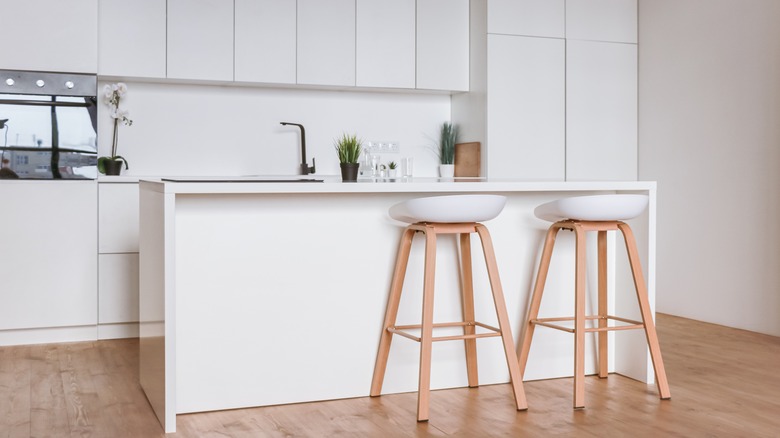How To Clean MDF Furniture
Most people have some wood-like furniture in their home or office that isn't truly wood. It could be a shelving unit, table, or even your kitchen cabinets. It's most likely made of medium-density fiberboard (MDF), a composite wood product that uses real wood fibers, resin, and wax as a core with a protective, decorative outer layer that is typically waterproof. According to Just Wood Furniture, it's incredibly common in the engineering of flat-pack furniture (the kind that you buy in a box and put together yourself) and cabinet doors. MDF is a popular choice because it's less expensive than wholly natural wood products, is readily available, and comes in a variety of sizes. Other attractive features include its ability to be pressed into complex designs during manufacturing and that it's pretty humidity-resistant due to its ability to shrink and expand.
And on the not-so-plus side, its engineered composition makes it h-e-a-v-y and the material, over time, can loosen its grip on the screws holding it together. So, moving it around for cleaning can be difficult and may cause damage. Furthermore, there are other challenges to consider when cleaning and caring for MDF furniture — but with a few quick tips, your MDF furniture can last many years.
Inspect your MDF piece carefully for damage
Before you begin cleaning, inspect your furniture carefully for any signs of damage. Scratches, bulges or swelling, and breaks in the material are significant indicators that the MDF has been compromised and additional care will be necessary to ensure no further damage results from cleaning it. Also look for wobbling or loose screws because these components can become less secure over time and may require repair to maintain the integrity of the structure.
According to Water Damage Plus, it's important to understand that water-resistant and waterproof are not the same thing. And any break in the protective surface of your furniture can allow moisture to absorb quickly into the MDF core. While MDF can withstand high humidity, when water reaches the core, severe problems occur that are sometimes not fixable. On a positive note, MDF can be coated with a non-water-based topcoat to help it resist water damage even further.
Treat damaged areas with care
MDF furniture can succumb to a variety of issues if not cared for properly. According to Water Damage Plus, pieces can become warped, buckled, swollen, and broken resulting in a breakdown of the MDF material. Some damaged areas will require repair before a thorough cleaning can be performed.
Fixing damaged areas might involve sanding, reshaping, or filling with wood putty or glue. Caution must be taken when working with the MDF core because it is likely that formaldehyde and fine particles will be released during the process, especially during sanding and cutting. Formaldehyde is used in the manufacture of many products and is a known carcinogen. Protective gear such as masks can be purchased at any local hardware or home goods store. Once repaired and fully dried, it should be safe to clean the furniture with a gentle dish soap and water mixture and a non-abrasive cloth or sponge.
Choose your cleaning products carefully
Gentle is best, according to Handhills Cabinets and Millwork. Since MDF and its protective covering is often prone to being easily scratched or marred, they recommend using a gentle dish soap and diluting it further so that the final solution is one part cleaner to two parts water. Strong chemicals, hard-bristled brushes, and abrasive scrubbers should be avoided because they can cause damage (sometimes subtle and unnoticeable until water seeps in and causes a problem) to the finish and ruin the look of your furniture.
Instead, choose soft sponges or other non-scratchy cloths (pure cotton or microfiber work best and are safe to use on MDF finishes). Before applying the wet, soapy cloth to your furniture, make sure to wring out any excess water so that it's just soapy and damp. Clean up any puddles quickly with paper towel or a soft, dry towel to reduce the likelihood of damage.
Avoid applying the chemical directly to the surface
Before you apply your soapy cloth to the surface, Atra Industrial Group suggests removing dust and loose debris with a dry, non-abrasive cloth such as one made of microfiber. A cotton cloth also works well for this task. If the item has an accumulation of dry debris on its surface, carefully use a handheld vacuum hose attachment to remove anything that could potentially mark or scratch the protective coating.
The next step is to use the soap solution to clean the surface, but avoid applying it directly to the furniture. Instead, soak it into the cloth or sponge, wring out the extra solution, and carefully wipe down the furniture, ensuring no excess liquid spills or seeps into crevices such as areas with hinges and exposed hardware. Afterward, wipe down again with soft cloth damped with plain water to remove any soap that may be lingering.
Drying the cleaned surface
One final step to properly clean and care for MDF furniture, according to Atra Idustrial Group, is to wipe away any remaining surface moisture with a clean, dry cloth made of non-abrasive material such as cotton or microfiber. It's a good practice to complete this step of the cleaning process even if moisture isn't visible.
If you find that water has somehow penetrated the protective surface through a micro-scratch or seam in the protective covering, you'll want to dry it out as quickly as possible. To do this, promote as much air circulation as possible with fans and a dehumidifier. Opening windows can also help, but Water Damage Plus recommends skipping it if the weather is humid or rainy because it will only make the drying process slower. By following these simple steps of routine care, MDF furniture can be an attractive addition to your home or office for many years.





